Fashion in ancient Pompeii was more than mere clothing; it was a vivid language of style, status, and self-expression. The garments and accessories worn by Roman men revealed their social rank, professions, and personal identity. Excavations of frescoes, statues, and textile fragments provide a rich tapestry illustrating how fashion functioned as a social code.
In Roman society, clothing held significant power. It communicated one’s place within the complex hierarchy of Pompeii—a city teeming with merchants, artisans, aristocrats, and slaves. Men’s fashion was especially telling: the choice of garment, fabric quality, color, and accessories could elevate a man’s public image or mark his civic role.
Understanding Roman men’s fashion in Pompeii sheds light on broader cultural values. It exposes how style served not only practical needs but also operated as a visible declaration of status and identity among the city’s male inhabitants. This social class divide is further exemplified in the daily lives of the citizens.
The influence of Ancient Rome extends beyond just fashion. It shaped various aspects of modern society, and its entertainment sector—ranging from gladiatorial games to chariot races—also played a significant role in societal dynamics.
For those interested in delving deeper into the fascinating world of Ancient Rome, Men of Pompeii serves as an ultimate online resource that offers engaging content bringing this rich history to life.
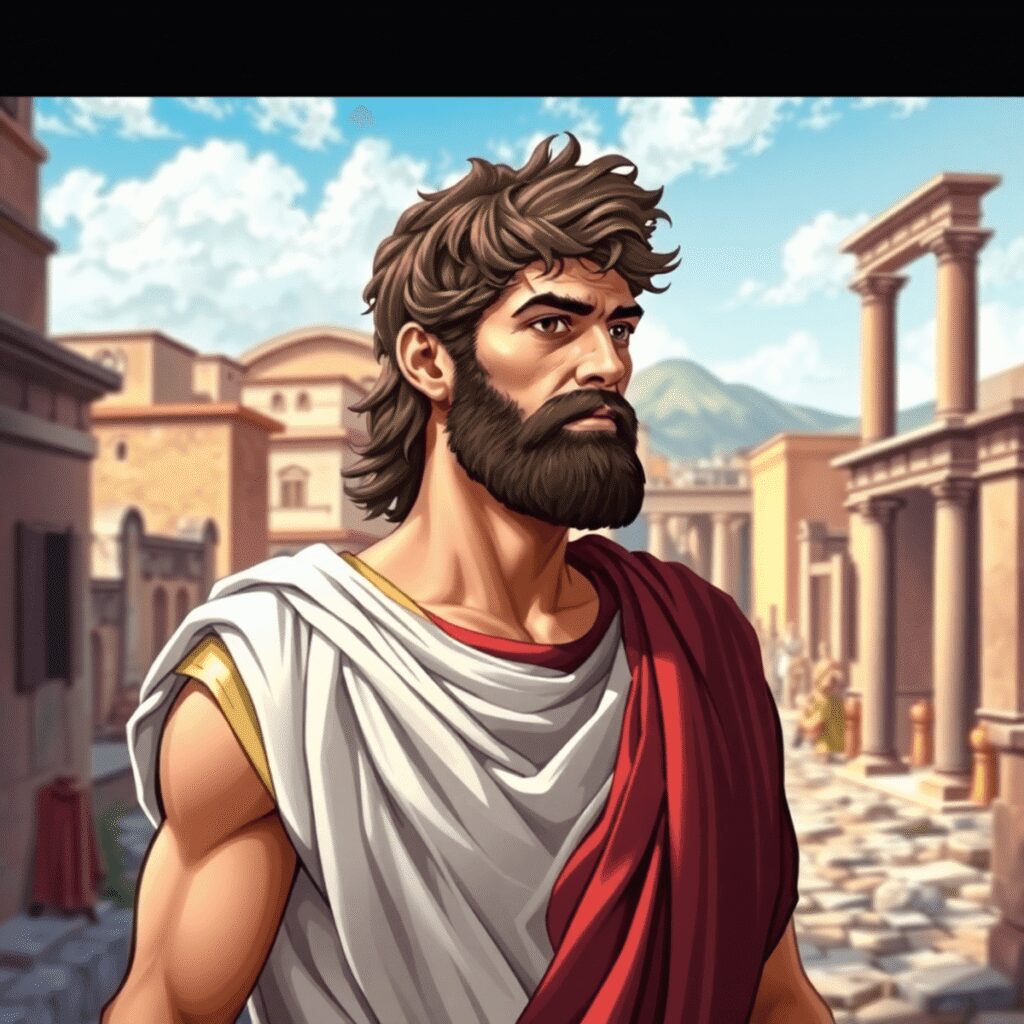
The Toga: Symbol of Status
The toga, a distinctive garment in ancient Rome, was not merely a piece of clothing but a symbol of social status and citizenship. It was a large piece of fabric draped over the body in a specific manner, requiring skill to wear correctly. Reserved for formal occasions and citizens, the toga represented Roman identity and dignity. It was mandatory for male citizens engaging in public affairs and ceremonies.
The significance of the toga in Roman society extended beyond its physical form. Toga colors denoted various distinctions such as the pure white toga virilis for Roman citizens, the purple-bordered toga praetexta for magistrates and priests, and the all-purple toga picta worn by triumphing generals as a mark of honor. These social status indicators reflected one’s position within Roman society.
However, it’s important to note that while the toga was a symbol of status for men, women’s legal status in ancient Rome was complex and often tied to their relationships with men, such as fathers or husbands. This intricate legal framework surrounding Roman women significantly influenced the gender dynamics of that era.
The style, color, and adornments of the toga were not just fashion choices but carried deep social meanings reflecting one’s position within Roman society. The impact of such societal structures is further mirrored in other aspects of Roman life, including their remarkable engineering feats which changed the world and served as a foundation for contemporary infrastructure systems.
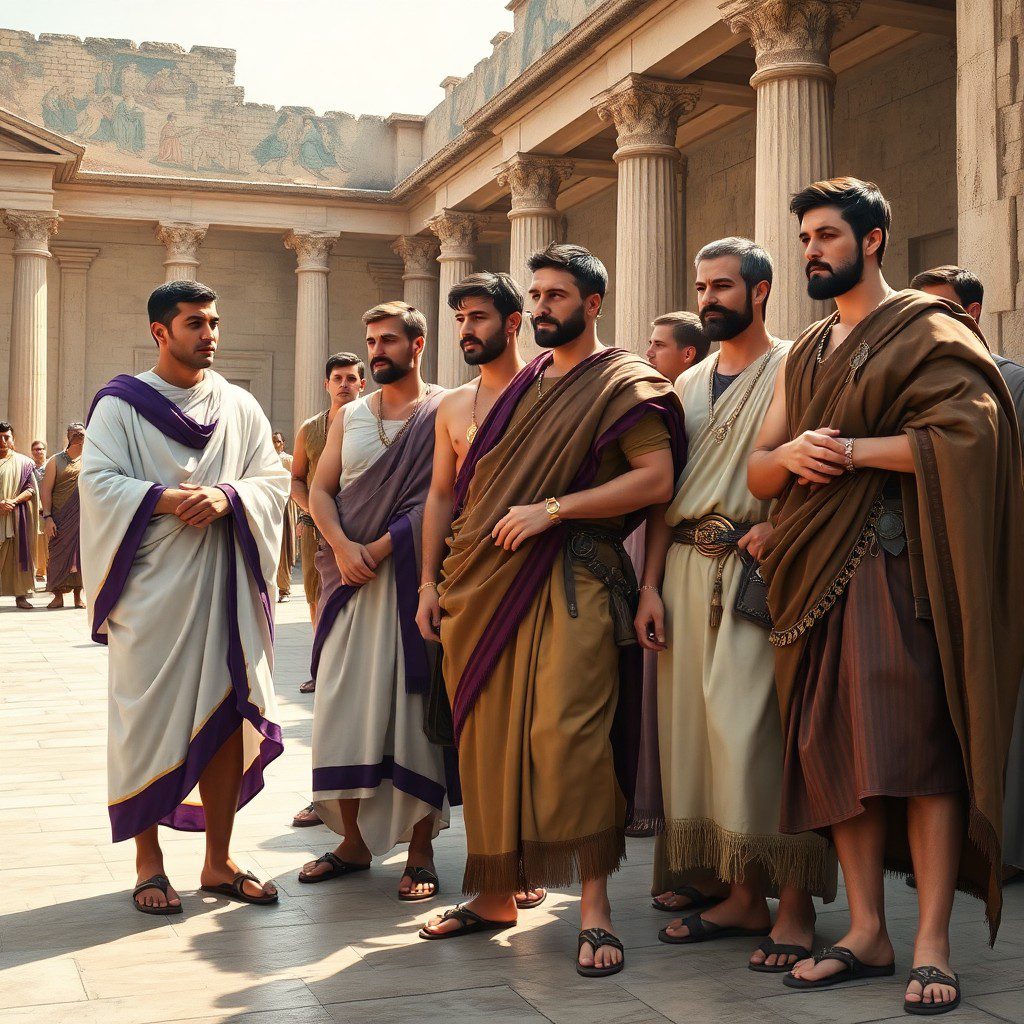
The Tunic: Practical Garment for Men
The tunic in ancient Rome was a staple garment worn by men of all social classes. It was more than just clothing; it served various purposes and was adapted for different activities such as work, leisure, and even ceremonies based on its style and decoration.
Key features of the tunic included:
- Simple construction: Usually made from wool or linen, tunics were rectangular pieces of fabric sewn together with openings for the head and arms.
- Length variations: Shorter tunics suited laborers and soldiers for ease of movement; longer versions indicated higher rank or wealth.
- Sleeve styles: Sleeves ranged from sleeveless to long-sleeved, offering functional and stylistic diversity.
The relationship between tunics and social status was clear: while poorer citizens, often plebeians, wore coarse, undyed fabrics, elite Pompeian men displayed their prosperity through luxurious textiles and detailed ornamentation on their tunics. This duality made the tunic both a practical garment and a subtle status symbol within Roman male fashion.
On the other hand, the patricians, who were the wealthy elite, often showcased their power through extravagant clothing such as finely crafted tunics.
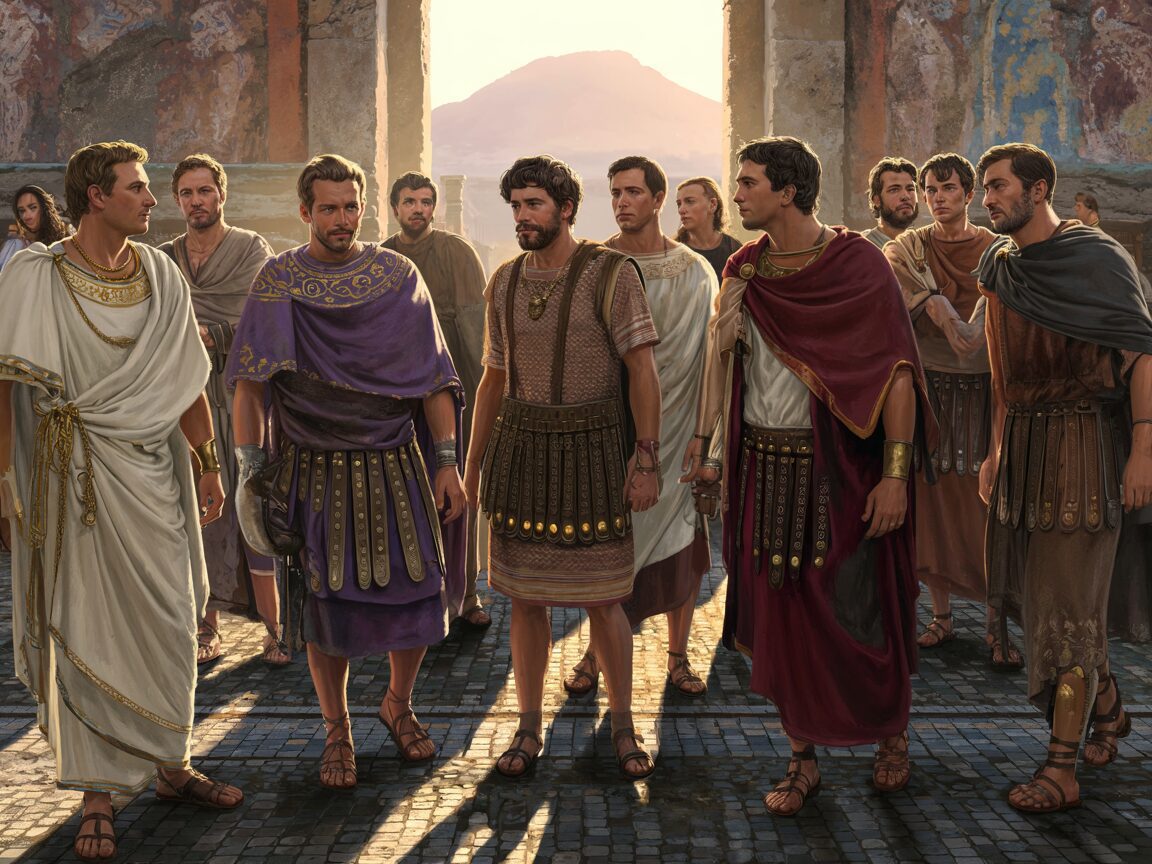
Outerwear for Protection and Style
Cloaks in ancient Rome were essential components of men’s outerwear, combining functionality and fashion to meet the needs of Pompeii’s climate and social customs. The geography of ancient Pompeii significantly influenced these choices, as the city’s unique location required specific clothing adaptations.
Pompeian men chose from several types of cloaks, each serving distinct purposes and reflecting personal taste.
Common types of cloaks included:
- Paenula: A heavy, poncho-like cloak made from wool, ideal for rainy weather. Its practical design covered the body fully, offering excellent protection against wind and rain.
- Lacerna: A lighter, semicircular cloak fastened at the shoulder with a fibula (brooch). The lacerna was popular for everyday wear, balancing comfort with style.
- Sagum: A military-style cloak often associated with soldiers but also worn by civilians during colder months. It symbolized strength and discipline.
The purpose of outerwear extended beyond mere protection. Cloaks were visible indicators of social status and personal identity. The quality of fabric, color choices, and decorative borders could signal wealth or rank within Roman society. For example, a finely woven wool cloak with dyed edges suggested higher status compared to a simple undyed paenula.
Winters in Pompeii required heavier woolen cloaks to combat dampness and chill from the nearby sea, while warmer seasons favored lighter fabrics allowing breathability without sacrificing elegance.
Men’s outerwear was an essential layer in expressing style, status, and self-expression among Roman males. Choosing the right cloak communicated not only readiness for weather but also conveyed social messages to peers in public spaces such as forums or baths.
This interplay between clothing and societal norms is just one aspect of the broader rise and fall of the Roman Empire, which has left an indelible mark on the world, shaping politics, culture, and society in ways that continue to resonate today. The influence of Roman mythology on modern culture is another testament to this enduring legacy. Furthermore, elements of Roman law, such as those found in the Corpus Juris Civilis, continue to shape contemporary legal systems worldwide.
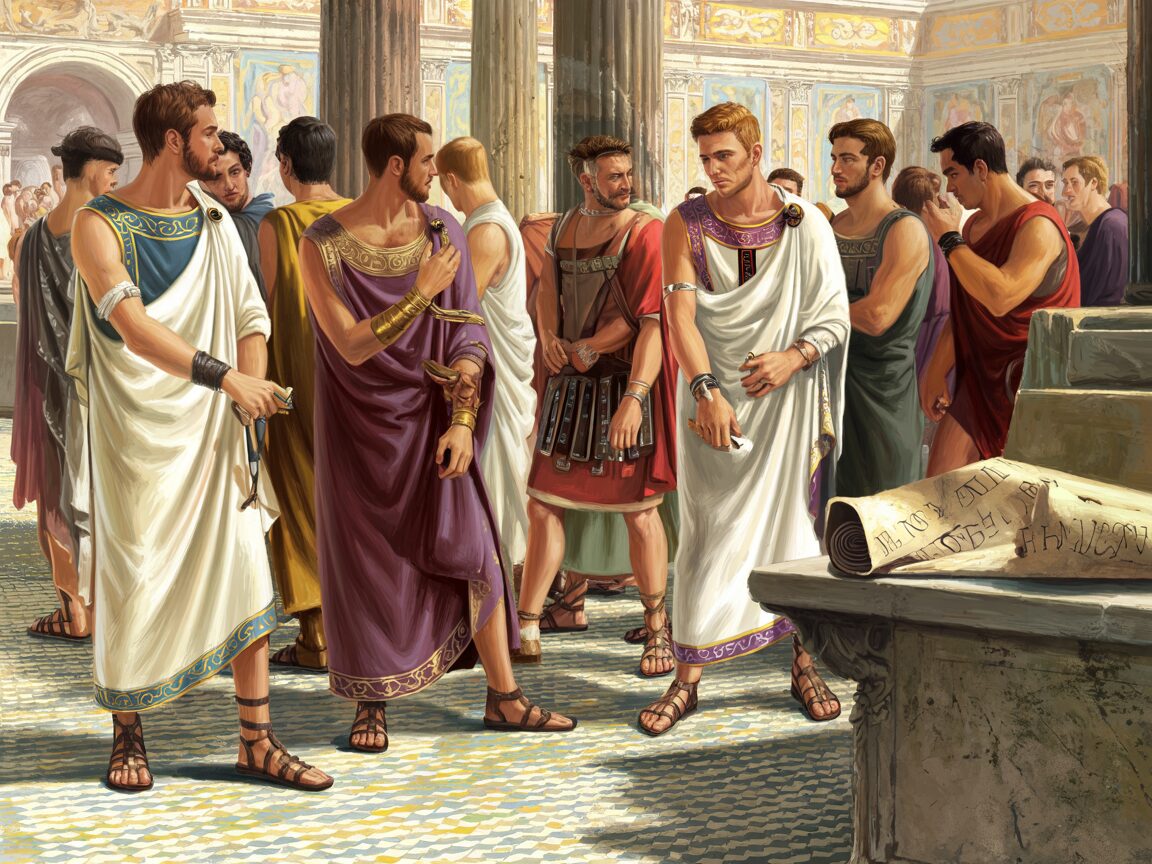
Footwear Choices for Roman Men
In ancient Pompeii, men had a variety of footwear choices to suit different occasions and social statuses. Closed shoes called calcei were commonly worn by elite men as a symbol of their higher social standing and formality. On the other hand, sandals, known as soleae, were more casual and practical options favored by the general population for everyday wear.
Footwear in Pompeii played a crucial role in signaling social status and occupation in Roman society. The type and quality of shoes worn by men often reflected their wealth, profession, and level of formality required by specific events. This is illustrated in the fleeting footwear fashions in ancient Rome which showcase how trends evolved over time.
By examining the footwear preferences of Pompeian men, we can gain valuable insights into their daily lives, social interactions, and self-presentation within the broader context of Roman fashion and society. This exploration could also lead us to understand other aspects of their lives such as the rise of Stoicism, the influence of the Roman Army, or the architectural innovations that characterized their era.
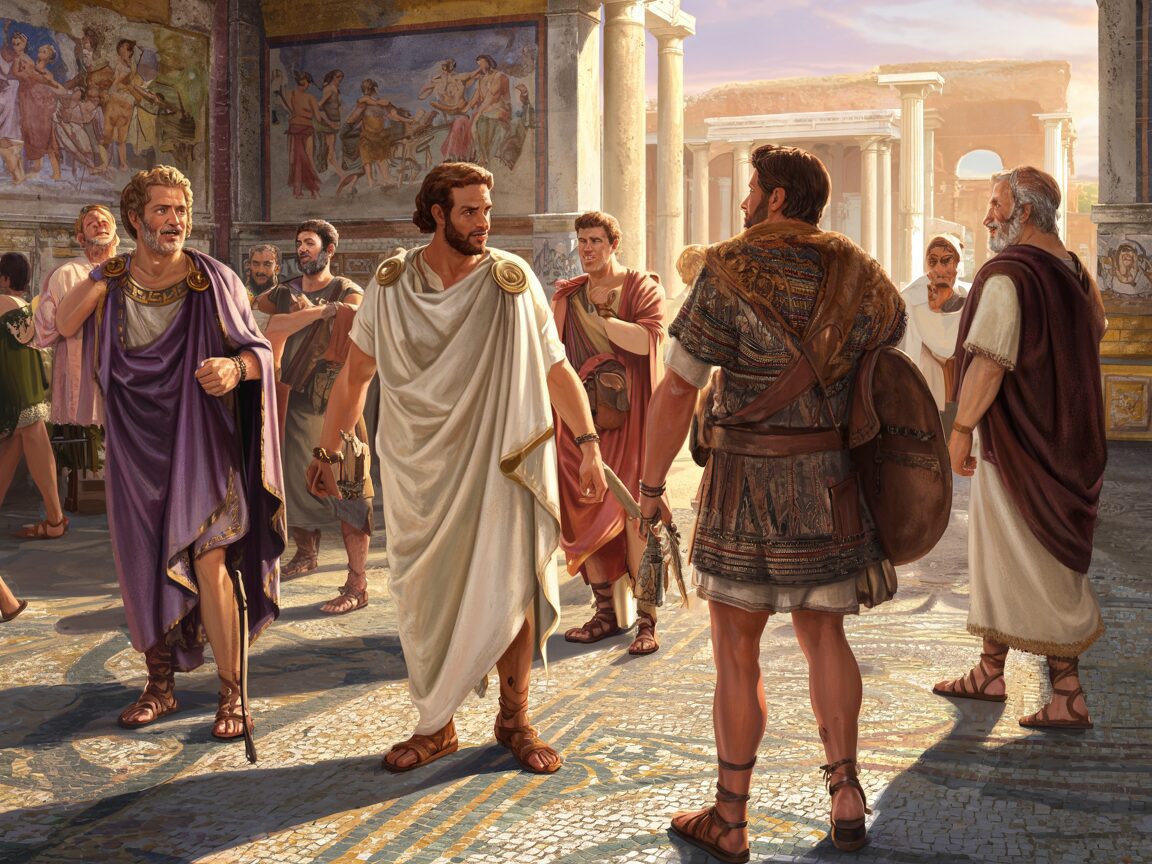
Jewelry, Accessories, Hairstyles, and Grooming Practices: The Complete Picture of Roman Male Fashion Expression
Jewelry in ancient Rome served as essential symbols of status and beauty for men, reflecting their wealth and social standing. Excavations in Pompeii have unearthed a variety of jewelry pieces worn by men, including intricately designed gold necklaces, elaborate silver bracelets, and ornate bronze rings with precious stones.
Belts were not just functional accessories but also fashion statements for Pompeian men. They were used to cinch tunics at the waist or hold decorative elements like brooches. Saddlebags were another common accessory that men used for practical purposes, allowing them to carry essential items while on the go.
Hairstyles in Pompeii played a significant role in defining male fashion trends. Men typically sported short, well-groomed haircuts that reflected their attention to personal appearance. In contrast, women often styled their hair with intricate braids, curls, and adorned them with ribbons and pins.
The grooming habits of Pompeian men included the use of various haircare products to maintain their desired look. These products ranged from scented oils for hair sheen to combs made from bone or ivory for styling.
Cultural influences heavily impacted grooming practices in Pompeii, with trends often mirroring those of Greek and Etruscan cultures. This blend of influences created a unique fashion landscape that emphasized both style and self-expression among Roman males.
It’s important to note that such expressions of individual style were not merely personal choices but also influenced by broader societal structures and norms established through legal systems like the Twelve Tables. These laws marked a significant milestone in the development of Roman law and legal history, codifying complex legal practices that shaped various aspects of life including fashion.
Moreover, the governance structure during this period, as explored in our piece about the Roman Republic’s governance, also played a crucial role in shaping societal norms and individual behaviors.
Lastly, the economic backdrop against which these fashion trends unfolded was significantly influenced by agricultural practices, which served as a crucial driver of Rome’s economic and social development.
Conclusion
The blend of Greek and Etruscan influences created a lively fashion scene in Pompeii, showcasing a rich mix of cultural interactions and artistic expressions. This not only reflects the evolution of Pompeian fashion, which mirrored the changing societal norms and preferences of each era, but also signifies the broader art and culture in ancient Rome, characterized by remarkable artistic expressions influenced by earlier traditions.
During the reign of the Antonine emperors, a new wave of trends emerged, with beards becoming a fashionable statement among Pompeian men. Political figures played a significant role in shaping style preferences, influencing the choices of clothing, accessories, and grooming practices adopted by the elite and general populace. This interplay between power dynamics and fashion choices highlighted the intricate relationship between politics and personal style in Pompeian society.
As we explore the world of fashionable men in Pompeii, we discover a story that goes beyond surface appearances. Fashion trends in Pompeii were not just about looking good; they were a form of self-expression, a way to assert one’s status, identity, and cultural affiliations within the Roman social hierarchy.
In examining the clothing choices of Pompeian men, we uncover a realm where garments were more than mere fabric and thread; they were a means of communication conveyed through intricate designs, luxurious materials, and exquisite accessories. The fashionable men of Pompeii epitomized style, embodied status, and celebrated self-expression through their ever-evolving fashion sensibilities. Understanding this evolution also necessitates recognizing pivotal historical moments such as the birth of the Roman Republic, which marked a critical shift from monarchical rule to a republican system around 509 BCE.

